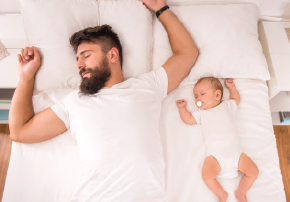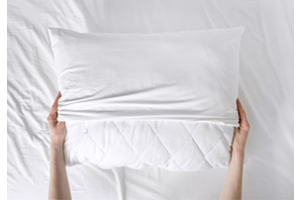Three Of The Best Ways To Sleep

Three Of The Best Ways To Sleep
“The sole purpose of sleep is to restore your physical, emotional and mental well-being after a long day”, says sleep scientist, Dr Dale Rae. Finding your ideal sleeping posture is important for a comfortably aligned spine. It also helps with proper breathing and managing pain or congestion. In any sleeping position, you want to keep the spine as neutral and relaxed as possible. Your spine houses the spinal cord, the essential conductor that connects brain signals with every part of our body. For a calm, recuperative night’s sleep, a good sleeping position is important.”
Sleeping on your front
Some say that sleeping on your stomach is not ideal. It may feel like a comforting, restful position to hug that pillow and drift off to dreamland, but you might be compromising your spine in several ways. Firstly, in order to breathe, your neck will need to be turned. Immediately, you are putting strain on the cervical spine, the area from the back of your head to your shoulders. Moreover, because your head is elevated, the strain on your spine can be transferred downwards in an unnatural, forward curvature through the middle and lower back. Sleeping on your stomach not only compromises your spine, it is also likely affecting the quality of your sleep.
Side sleeping
Sleeping on your side is much easier on your spine. Even in this position, there are ways you can alleviate unnatural curvatures and neutralize your spine posture. There is a reason why side sleepers might typically turn over back and forth during the night. It’s because your spine might not be comfortably aligned in this position. Your arms might begin to feel numb. Your shoulders and hips could start to feel a little strained. Eventually, you feel a twinge and roll over to the other side to relieve the pressure on your spine. We’ll share a few tips below about how you can manage this.
Sleeping on your back
Lying prone on your back provides the most neutralized posture of the spine. But this may seem quite clinical and not the most comforting way to relax. You may feel like you’re in a space pod. And does anyone really sleep in one posture throughout the night? The point here, is that by finding the most neutralized position of your spine for your preferred sleeping position, you will likely sleep in longer, deeper cycles of restorative rest.
Tips for better sleeping positions
We’re so used to the idea of pillows supporting our heads. But cushioning can be used in different ways to achieve better spine posture. Let’s review the more optimal sleeping positions – side sleeping and back sleeping – and how we can manipulate our position for even better posture.
Side slide pillows
Techniques for optimal side sleeping are slightly different for men and women. Men tend to have squarer torsos. Women have a curvature with a narrower waist and larger hips. A more responsive mattress technology would help, gently holding the hips while supporting the waist. You can also try sliding a pillow beneath the waist, the lumbar position of the spine, to support a more neutralized posture.
Another way of straightening out your spine in a side position is to place a pillow in between your lower legs. This makes the upper legs more parallel with your mattress, which in turn supports the lower spine.
Let’s say you sleep to the side with one knee rolled over the other. It’s a common sleeping position. However, consider how you are rotating the middle and back of your spine with one leg wrapped over the other. This is not a sustainable position. You may begin to feel a discomfort and likely roll over to assume the same position on the other side. Instead, try supporting the extended knee with a pillow, keeping the top leg thigh parallel with the mattress. Again, your spine will be better aligned.
When is side sleeping best?
Do you snore? Do you have sleep apnoea? For those people who have difficulty breathing during sleep, sleeping on your back might exacerbate these problems. Choosing a slide sleeping position can make breathing easier for some people.
Pregnancy can play havoc with your normal sleeping pattern. In advanced pregnancy, you likely need back relief at night. Consider using leg, knee and waist cushioning to neutralize your spine position. Side sleeping also provides optimal blood flow for both mom and baby-to-be.
What is the best back sleeping position?
Sleeping on your back can be compromised by a big, fluffy pillow at your head which immediately strains the neck in an upright position. Ideally, your ears should be aligned with your shoulders for a straight spine position. But if you take the pillow away, your head position might then lean a little too far back. Consider getting a soft roller cushion that goes under your neck to support and hold an aligned spine. Remember also, the level of comfort and support you choose in a mattress may impact how you need to support your head. If you choose a softer, plush mattress, your body will sink in further. You will need to adjust your head position accordingly.
How should couples best sleep together?
New relationships usually involve close and intimate sleeping patterns. Tangling, nuzzling and spooning can mean all sorts of contortions which, however loving, are not really practical for meaningful, deep sleep. A good night’s sleep is what’s needed for a growing relationship. Even the most compatible couples are not necessarily great co-sleepers.
As a relationship matures and becomes more secure, the liberty position of sleeping back to back can give both partners easier breathing space and a more relaxed posture. Consider investing in a well-engineered, motion isolating mattress. A common trick is to join two single or double beds that allow uninterrupted sleep, particularly if one of you is a light sleeper.
How can you correct your sleeping position?
“Don’t overthink this”, adds Dr Rae. “Just pay attention to the quality of sleep you’re getting and perhaps experiment with different positioning and cushioning. The key consideration is an optimally positioned, neutral spine, easy breathing and no pain or numbness.” If you find yourself habitually sleeping on your stomach, try a simple trick of strapping a tennis ball to your chest. You can tape this to the front of your sleep shirt. Whenever you try to roll over in your sleep you will inherently feel the discomfort and reassume your previous position.
Not sleeping? Consult the experts
Dial•a•Bed takes your sleep seriously. So should you. That’s why we work closely with sleep scientist, Dr Dale Rae, to bring you practical insight and guidance to finding what Dr Rae calls your “sleep sweet spot”. Everybody has different sleep patterns. What matters is that you find the “sweet spot” that works for you. If you are experiencing prolonged sleep interruptions, or would like to understand your sleep better, consider a well-researched scientific approach. Find out more at www.sleepscience.co.za






